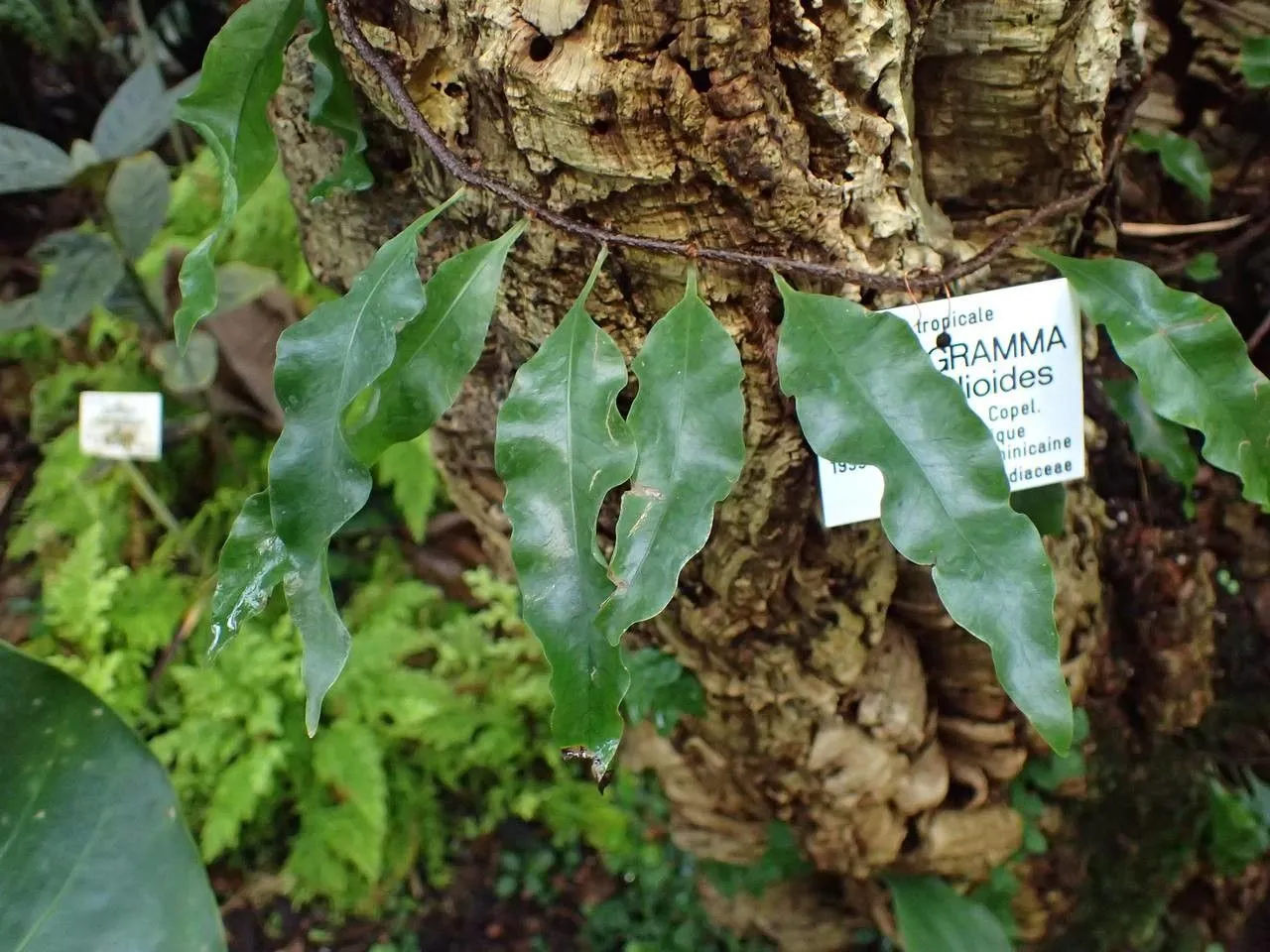
Author: (L.) Copel.
Bibliography: Gen. Fil.: 185 (1947)
Year: 1947
Status: accepted
Rank: species
Genus: Microgramma
Vegetable: False
Observations: Mexico to Trop. America
The Clubmoss Snakefern, scientifically known as Microgramma lycopodioides, is an intriguing and noteworthy species belonging to the Polypodiaceae family. This unique fern captures interest due to its distinctive appearance and widespread habitat range, extending from Mexico to tropical regions within the Americas.
One of the salient features of the Clubmoss Snakefern is its resemblance to the clubmoss, which contributes to its common name. The fern’s leafy fronds are typically small and linear, often forming dense mats that can cover the surfaces of its surroundings. These fronds present a lush, green vitality that makes the plant easily identifiable and visually appealing.
Microgramma lycopodioides thrives in a variety of environments across its geographic range. Its adaptability allows it to flourish in humid and tropical conditions, often found clinging to the trunks of trees or nestled on rocky formations within the forest. This epiphytic nature—growing on other plants, especially trees—highlights its ability to secure nutrients and moisture from the air and its immediate environment, rather than relying solely on soil.
Dating back to its initial classification, the Clubmoss Snakefern was described in the botanical literature “Gen. Fil.” in 1947. The contribution of Copeland to its scientific documentation marks an important moment in understanding its classification and characteristics.
Moreover, historical botanical texts reveal that Microgramma lycopodioides was initially described by Carl Linnaeus, denoted by the abbreviation (L.). Linnaeus’s early identification and Copeland’s later contributions have solidified the fern’s standing within the botanical community.
This fern is more than just a botanical curiosity; it plays a part in the larger ecosystem. Epiphytic plants like the Clubmoss Snakefern contribute to the biodiversity of their habitats. They provide microenvironments for other organisms and participate in nutrient cycles that sustain the health of tropical ecosystems.
In conclusion, the Clubmoss Snakefern, Microgramma lycopodioides, is a fascinating species with a notable presence from Mexico to the tropical Americas. Its lush, distinctive fronds and epiphytic growth habits make it a unique member of the Polypodiaceae family. Through historical and scientific exploration, the contributions by notable botanists have carved a detailed narrative of its existence and importance within its natural habitat.
Eng: clubmoss snakefern, bastard catclaw
En: Clubmoss snakefern, Bastard Catclaw
Taken Oct 9, 2009 by OTS – Oviedo-Brenes, Federico (cc-by-nc-sa)
Taken Apr 7, 2020 by Sébastien TRASBOT (cc-by-sa)
Taken Aug 12, 2022 by manuseitz (cc-by-sa)
Taken Aug 12, 2022 by manuseitz (cc-by-sa)
Taken Feb 5, 2017 by Yoan MARTIN (cc-by-sa)
Taken Apr 17, 2019 by OTS – O. Vargas (cc-by-nc-sa)
Taken Feb 5, 2017 by Yoan MARTIN (cc-by-sa)
Taken Aug 12, 2022 by manuseitz (cc-by-sa)
Taken Aug 12, 2022 by manuseitz (cc-by-sa)
Taken Feb 5, 2017 by Yoan MARTIN (cc-by-sa)
Taken Aug 3, 2022 by Gabriel Gabriel Caldas (cc-by-sa)
Taken Feb 5, 2017 by Yoan MARTIN (cc-by-sa)
Taken Aug 12, 2022 by manuseitz (cc-by-sa)
Taken Aug 12, 2022 by manuseitz (cc-by-sa)
Taken Aug 12, 2022 by manuseitz (cc-by-sa)
Taken May 29, 2021 by Jacques Maréchal (cc-by-sa)
© copyright of the Board of Trustees of the Royal Botanic Gardens, Kew.
© copyright of the Board of Trustees of the Royal Botanic Gardens, Kew.
© copyright of the Board of Trustees of the Royal Botanic Gardens, Kew.
Taken Jun 9, 2011 by OTS – Chaves-Fallas, José Miguel (cc-by-nc-sa)
Taken Oct 9, 2009 by OTS – Oviedo-Brenes, Federico (cc-by-nc-sa)
Taken Oct 9, 2009 by OTS – Oviedo-Brenes, Federico (cc-by-nc-sa)
Taken Jun 9, 2011 by OTS – Chaves-Fallas, José Miguel (cc-by-nc-sa)
Taken Oct 9, 2009 by OTS – Oviedo-Brenes, Federico (cc-by-nc-sa)
Growth habit>: Vine, Forb/herb
Family: Myrtaceae Author: (F.Muell.) K.D.Hill & L.A.S.Johnson Bibliography: Telopea 6: 402 (1995) Year: 1995 Status:…
Family: Rubiaceae Author: Pierre ex A.Froehner Bibliography: Notizbl. Bot. Gart. Berlin-Dahlem 1: 237 (1897) Year:…
Family: Sapindaceae Author: Koidz. Bibliography: J. Coll. Sci. Imp. Univ. Tokyo 32(1): 38 (1911) Year:…
Family: Asteraceae Author: A.Gray Bibliography: Pacif. Railr. Rep.: 107 (1857) Year: 1857 Status: accepted Rank:…
Family: Fabaceae Author: Medik. Bibliography: Vorles. Churpfälz. Phys.-Ökon. Ges. 2: 398 (1787) Year: 1787 Status:…
Family: Aspleniaceae Author: (Cav.) Alston Bibliography: Bull. Misc. Inform. Kew 1932: 309 (1932) Year: 1932…